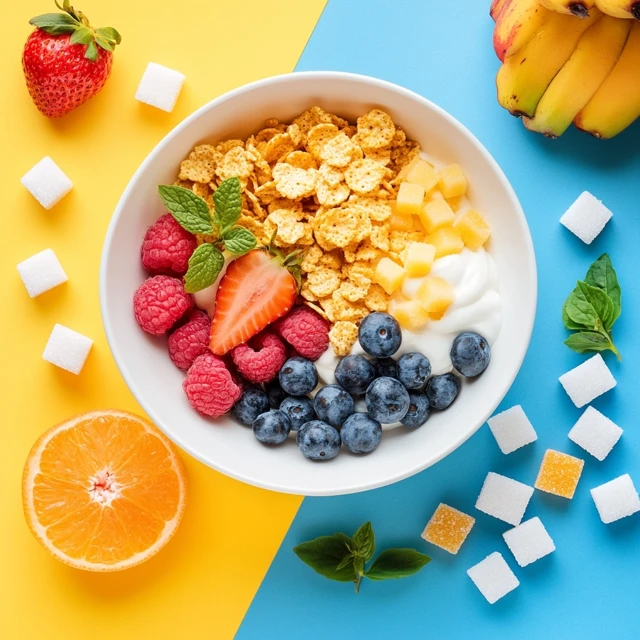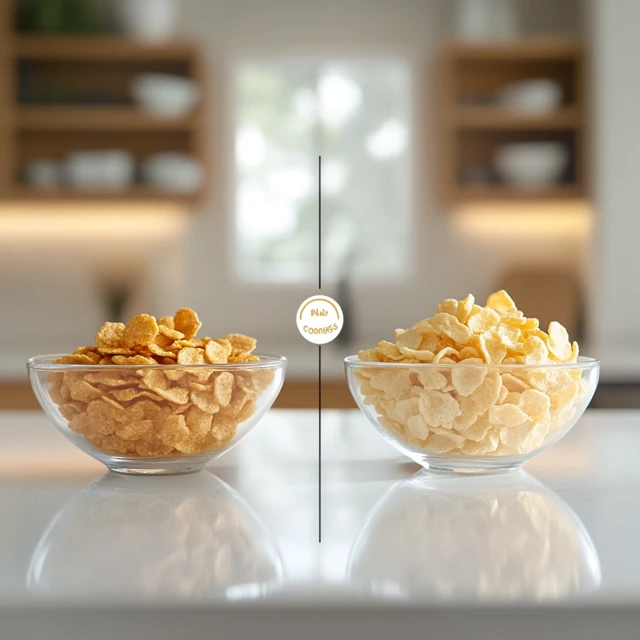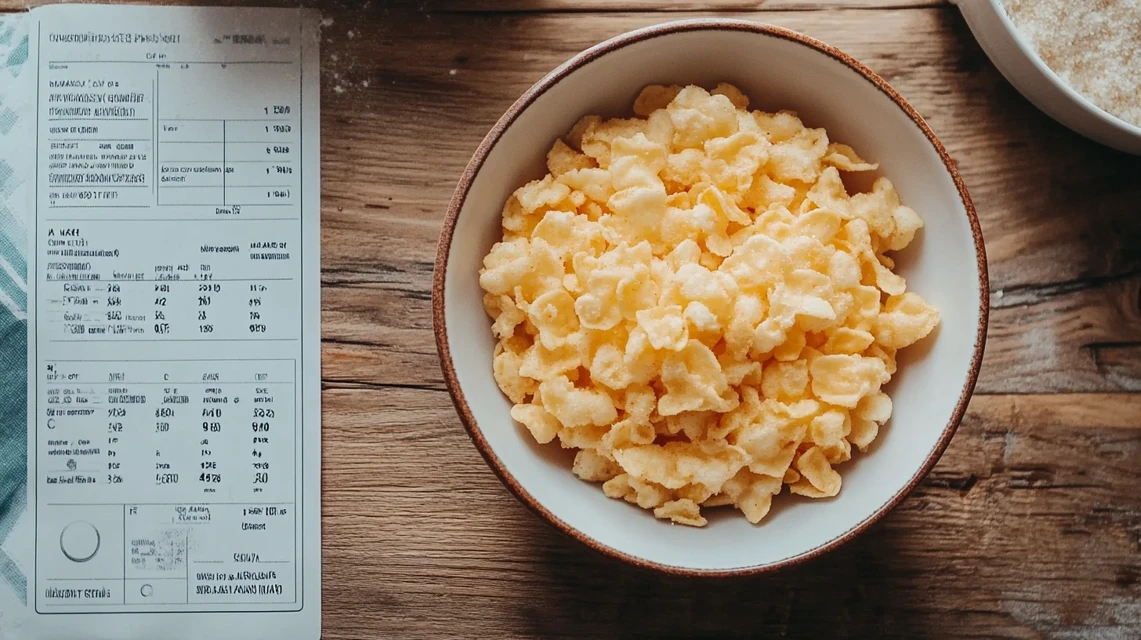When it comes to breakfast, corn flakes are often seen as a healthy choice. But for those mindful of sugar intake, the question arises: Is there a lot of sugar in corn flakes? To answer this, we need to explore the sugar levels in corn flakes, the factors that affect sugar content, and how to make them part of a balanced diet.
Understanding Sugar Levels in Corn Flakes
Sugar plays an important role in food, not only adding sweetness but also enhancing flavor and texture. However, understanding what qualifies as “a lot of sugar” is key to evaluating corn flakes as a breakfast option.
What is Considered a Lot of Sugar?
The amount of sugar considered excessive varies depending on dietary guidelines. According to the World Health Organization (WHO):
- Men: Should consume no more than 36 grams of added sugar per day.
- Women: Should limit added sugar to 25 grams per day.
- Children: Should consume less than 25 grams of sugar daily.
When compared to these limits, corn flakes are generally on the lower end of the spectrum. However, the total sugar content in your bowl can quickly increase depending on portion sizes and added toppings.
Sugar Content in Plain Corn Flakes
Plain corn flakes contain about 2-3 grams of sugar per 30-gram serving (approximately 1 cup). This small amount of sugar is typically added during production to enhance the flavor. While this is a modest amount, it’s still worth noting for those on low-sugar diets.
For example:
- A standard serving of plain corn flakes contributes to less than 10% of the daily recommended sugar intake for women.
- Even for children, the sugar in plain corn flakes remains within a safe range when consumed in moderation.
How Sweetened Corn Flakes Compare
Sweetened varieties of corn flakes contain significantly more sugar. These include options like frosted flakes or flavored cereals. On average:
- Frosted flakes: Contain 10-12 grams of sugar per serving, quadruple the amount in plain corn flakes.
- Chocolate-flavored flakes: Often have 12-15 grams of sugar per serving.
These numbers highlight the importance of choosing unsweetened versions if you want to keep your sugar intake low. Reading the nutrition label is essential to make informed decisions.
Factors Affecting Sugar in Corn Flakes
The sugar content in corn flakes is not just about the cereal itself. Other factors, such as added ingredients and portion sizes, can significantly impact your overall sugar intake.
Added Sugars and Flavoring
Many corn flakes manufacturers add sweeteners like sugar, malt extract, or corn syrup during production. These additives improve taste and texture but can increase sugar levels. While plain corn flakes keep added sugar to a minimum, flavored varieties use these sweeteners more liberally to cater to specific taste preferences.
For example:
- Plain corn flakes: Typically list sugar lower on the ingredients list, indicating minimal amounts.
- Sweetened corn flakes: List sugar or syrup higher up, meaning it is a major ingredient.
By checking the label, you can determine whether a product aligns with your dietary goals.
check out this https://eassyrecipes.com/category/breakfast/
Impact of Toppings and Mix-ins

Toppings can turn a low-sugar bowl of corn flakes into a sugar-loaded meal. Common mix-ins like sugar, honey, or flavored milk add significant amounts of sugar to your breakfast.
Here’s a quick breakdown:
- 1 tablespoon of sugar: Adds 12 grams of sugar.
- 1 teaspoon of honey: Adds 5-6 grams of sugar.
- 1 cup of sweetened almond milk: Can add 10 grams of sugar or more.
Instead of sugary toppings, consider adding fresh fruit, which provides natural sweetness along with vitamins and fiber.
Portion Size and Sugar Intake
Another factor to consider is how much corn flakes you serve yourself. The recommended serving size is 30 grams, but many people unknowingly pour larger portions. For instance:
- A 60-gram portion of plain corn flakes doubles the sugar content to 4-6 grams.
- Sweetened varieties in larger portions can contribute 20-30 grams of sugar, close to or exceeding daily limits.
Using a measuring cup to portion out your cereal can help you manage sugar intake effectively.
Balancing Sugar Levels in Corn Flakes
While plain corn flakes are relatively low in sugar, making mindful choices about portion size, toppings, and milk can further reduce sugar consumption. Understanding these factors ensures you can enjoy cornflakes without compromising your dietary goals.
Health Implications of Sugar in Corn Flakes
While corn flakes are a breakfast staple for many, their sugar content—though generally low—can still have an impact on your health, especially when combined with other factors. Understanding these implications is essential for making informed dietary choices.
Effects on Blood Sugar Levels
Even though plain corn flakes are relatively low in sugar, they can still influence blood sugar levels due to their high glycemic index (GI). The GI measures how quickly a food causes blood sugar to rise. Foods with a high GI, like corn flakes, are digested rapidly, which can lead to:
- Blood Sugar Spikes: After eating cornflakes, blood sugar levels may rise quickly, followed by a rapid decline. This can cause energy crashes and increased hunger soon after breakfast.
- Increased Insulin Response: High-GI foods prompt the body to release more insulin to manage the sugar spike, which, over time, can strain the pancreas and potentially increase the risk of insulin resistance.
To mitigate these effects, pairing corn flakes with protein or fiber-rich foods like nuts, seeds, or Greek yogurt can slow sugar absorption and maintain stable energy levels throughout the morning.
check out this https://eassyrecipes.com/category/breakfast/
Risks of Excess Sugar Consumption
Excessive sugar intake, whether from corn flakes or other sources, can contribute to a range of health issues over time. While plain corn flakes are not inherently high in sugar, adding sweeteners, toppings, or using flavored milk can push sugar levels into the unhealthy range.
Here are some potential risks of consuming too much sugar:
- Weight Gain: Excess sugar contributes to higher calorie intake, increasing the risk of obesity. This is especially true when sugar-rich breakfasts are paired with a sedentary lifestyle.
- Increased Risk of Type 2 Diabetes: Regularly consuming sugary foods can lead to insulin resistance, a key factor in developing diabetes.
- Heart Health Problems: Diets high in sugar have been linked to increased triglyceride levels, which can raise the risk of heart disease.
- Dental Issues: Sugary foods, including cereals with added sugar, can lead to cavities and other dental problems, especially when eaten frequently without proper oral care.
For those looking to reduce these risks, monitoring sugar intake from corn flakes and other meals is essential.
Tips for a Healthier Breakfast

A nutritious breakfast sets the tone for the rest of the day. To enjoy corn flakes while keeping your meal healthy and balanced, consider these simple tips:
- Choose Unsweetened Corn Flakes:
- Opt for plain corn flakes with minimal added sugar. Check the ingredient label and select products with 2-3 grams of sugar per serving or less.
- Add Natural Sweeteners:
- Replace refined sugar or honey with naturally sweet toppings like fresh fruit. Berries, bananas, or sliced apples provide natural sugars along with fiber, vitamins, and antioxidants.
- Pair with Protein and Fiber:
- To lower the glycemic impact of your breakfast, combine corn flakes with high-protein and high-fiber foods. Examples include:
- A handful of nuts or seeds.
- A dollop of Greek yogurt.
- A spoonful of chia seeds or flaxseeds.
- To lower the glycemic impact of your breakfast, combine corn flakes with high-protein and high-fiber foods. Examples include:
- Control Portion Sizes:
- Stick to the recommended serving size of 30 grams (1 cup) to avoid consuming more sugar than intended. Use a measuring cup to ensure accuracy.
- Choose Low-Sugar Milk Options:
- Use unsweetened plant-based milks like almond, soy, or oat milk to avoid the added sugars found in flavored or sweetened dairy products.
- Diversify Your Breakfast:
- Rotate corn flakes with other low-sugar breakfast options like oatmeal, whole-grain toast, or smoothies. This prevents over-reliance on one type of food and ensures a balanced diet.
By following these tips, you can enjoy cornflakes as part of a wholesome breakfast without worrying about excess sugar.
check out this https://eassyrecipes.com/category/breakfast/
FAQs About Sugar in Corn Flakes
When it comes to cornflakes, many people wonder about their sugar content and how they fit into different dietary needs. Here are answers to some frequently asked questions.
Are Corn Flakes High in Sugar?
Plain cornflakes are considered low in sugar compared to many other breakfast cereals. A standard 30-gram serving contains about 2-3 grams of sugar, which is a relatively small amount. However, sweetened varieties, like frosted flakes or chocolate-flavored cereals, can contain 10-15 grams of sugar per serving, making them much higher in sugar.
To enjoy a healthier option, stick to plain cornflakes and check the label to confirm the sugar content.
Can I Eat Corn Flakes During a No Sugar Diet?
Eating cornflakes on a no-sugar diet depends on how strictly you define “no sugar.” Most plain cornflakes contain a small amount of added sugar—typically 2-3 grams per serving—to enhance flavor. While this is minimal, it may not comply with strict no-sugar diets that eliminate all added sugars.
If your diet allows natural sugars but avoids added ones, look for unsweetened corn flakes. Pair them with unsweetened milk and avoid sugary toppings to keep your meal compliant.
How Much Sugar Is in a Bowl of Cornflakes?
The sugar content in a bowl of cornflakes depends on the serving size and any added ingredients. For a standard 30-gram serving of plain cornflakes:
- Without milk: 2-3 grams of sugar.
- With whole milk: Adds 5 grams of lactose, resulting in a total of 7-8 grams of sugar.
- With sweetened milk or toppings like sugar or honey: Can increase the sugar content significantly, reaching 15-20 grams or more.
To control sugar intake, measure your portions and opt for unsweetened milk and fresh fruit instead of sugary toppings.
Is Cornflakes Good for Sugar?
For those monitoring blood sugar levels, cornflakes may not be the best choice despite their low sugar content. This is because they have a high glycemic index (GI), meaning they cause a rapid spike in blood sugar levels when consumed alone.
To make cornflakes better for managing sugar:
- Pair them with high-fiber toppings like berries or seeds.
- Add protein-rich foods such as Greek yogurt or nuts.
- Use a smaller portion size and combine it with other low-GI foods.
While corn flakes can be part of a balanced diet, those with diabetes or prediabetes should consume them in moderation and with complementary foods.
Conclusion
Corn flakes are a versatile breakfast option that can be enjoyed in a healthy way with some mindful choices. Plain cornflakes are relatively low in sugar, making them a better option compared to sweetened cereals. However, toppings, portion sizes, and the type of milk you use can significantly impact the total sugar content in your bowl.
By choosing unsweetened varieties, measuring your portions, and pairing them with fiber and protein, you can enjoy cornflakes as part of a balanced breakfast. Whether you’re following a no-sugar diet, managing blood sugar levels, or simply aiming for a healthier meal, making small adjustments ensures that cornflakes remain a convenient and nutritious choice.

